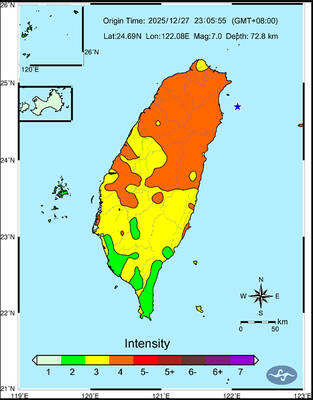Australia, Peru and Vietnam have expressed interest in joining a budding Asia-Pacific tariff-busting plan that received a boost yesterday with the participation of the US, officials said.
On the sidelines of the UN General Assembly in New York, US Trade Representative Susan Schwab announced the launching of negotiations for the US to join a free trade agreement now confined to Singapore, New Zealand, Chile and Brunei.
The “Comprehensive Trans-Pacific Strategic Economic Partnership” agreement, the first trade pact involving a group of Pacific Rim countries, has a broad objective of tearing down trade barriers among participants within a decade.
The first round of negotiations for participation of the US, which has already joined discussions to free up investment and financial services among the five, will be held early next year in Singapore.
“While the United States is the first additional country to seek to join the four original members of the [agreement], we are confident that other countries in the region will ultimately embrace the benefits of participation,” Schwab told a news conference, with ministers from the four countries beside her.
“This high-standard regional agreement will enhance the competitiveness of the countries that are part of it and help promote and facilitate trade and investment among them, increasing their economic growth and development,” she said.
She did not name the countries that had shown interest in joining but officials said they were Australia, Peru and Vietnam.
“I think Australia has shown considerable interest — Peru as well — and there could be one or two other countries,” Singaporean Foreign Minister George Yeo (楊榮文) said.
“I know Vietnam is studying it very closely ... I am hopeful other countries will also come around,” he said.
The US decision to join the agreement will give impetus to a long-term initiative within the 21-member APEC forum to forge a free-trade agreement of the Asia-Pacific, officials said.
Aside from the US, Australia, Singapore, Chile, New Zealand, Brunei, Vietnam and Peru, APEC consists of China, Russia, Japan, Canada and other key economies.
Economies in the APEC group, which has a loose objective of achieving free trade and investment in the Pacific Rim by 2020, account for nearly half of world trade.
Yeo indicated that some APEC members could even join the trans-Pacific agreement before the APEC summit in Peru in November.
Under the agreement, tariffs on all trade products are eliminated within 12 years, with tariffs on 90 percent of trade in goods among the parties eliminated immediately.

A magnitude 7.0 earthquake struck off Yilan at 11:05pm yesterday, the Central Weather Administration (CWA) said. The epicenter was located at sea, about 32.3km east of Yilan County Hall, at a depth of 72.8km, CWA data showed There were no immediate reports of damage. The intensity of the quake, which gauges the actual effect of a seismic event, measured 4 in Yilan County area on Taiwan’s seven-tier intensity scale, the data showed. It measured 4 in other parts of eastern, northern and central Taiwan as well as Tainan, and 3 in Kaohsiung and Pingtung County, and 2 in Lienchiang and Penghu counties and 1

FOREIGN INTERFERENCE: Beijing would likely intensify public opinion warfare in next year’s local elections to prevent Lai from getting re-elected, the ‘Yomiuri Shimbun’ said Internal documents from a Chinese artificial intelligence (AI) company indicated that China has been using the technology to intervene in foreign elections, including propaganda targeting Taiwan’s local elections next year and presidential elections in 2028, a Japanese newspaper reported yesterday. The Institute of National Security of Vanderbilt University obtained nearly 400 pages of documents from GoLaxy, a company with ties to the Chinese government, and found evidence that it had apparently deployed sophisticated, AI-driven propaganda campaigns in Hong Kong and Taiwan to shape public opinion, the Yomiuri Shimbun reported. GoLaxy provides insights, situation analysis and public opinion-shaping technology by conducting network surveillance

‘POLITICAL GAME’: DPP lawmakers said the motion would not meet the legislative threshold needed, and accused the KMT and the TPP of trivializing the Constitution The Legislative Yuan yesterday approved a motion to initiate impeachment proceedings against President William Lai (賴清德), saying he had undermined Taiwan’s constitutional order and democracy. The motion was approved 61-50 by lawmakers from the main opposition Chinese Nationalist Party (KMT) and the smaller Taiwan People’s Party (TPP), who together hold a legislative majority. Under the motion, a roll call vote for impeachment would be held on May 19 next year, after various hearings are held and Lai is given the chance to defend himself. The move came after Lai on Monday last week did not promulgate an amendment passed by the legislature that

AFTERMATH: The Taipei City Government said it received 39 minor incident reports including gas leaks, water leaks and outages, and a damaged traffic signal A magnitude 7.0 earthquake struck off Taiwan’s northeastern coast late on Saturday, producing only two major aftershocks as of yesterday noon, the Central Weather Administration (CWA) said. The limited aftershocks contrast with last year’s major earthquake in Hualien County, as Saturday’s earthquake occurred at a greater depth in a subduction zone. Saturday’s earthquake struck at 11:05pm, with its hypocenter about 32.3km east of Yilan County Hall, at a depth of 72.8km. Shaking was felt in 17 administrative regions north of Tainan and in eastern Taiwan, reaching intensity level 4 on Taiwan’s seven-tier seismic scale, the CWA said. In Hualien, the